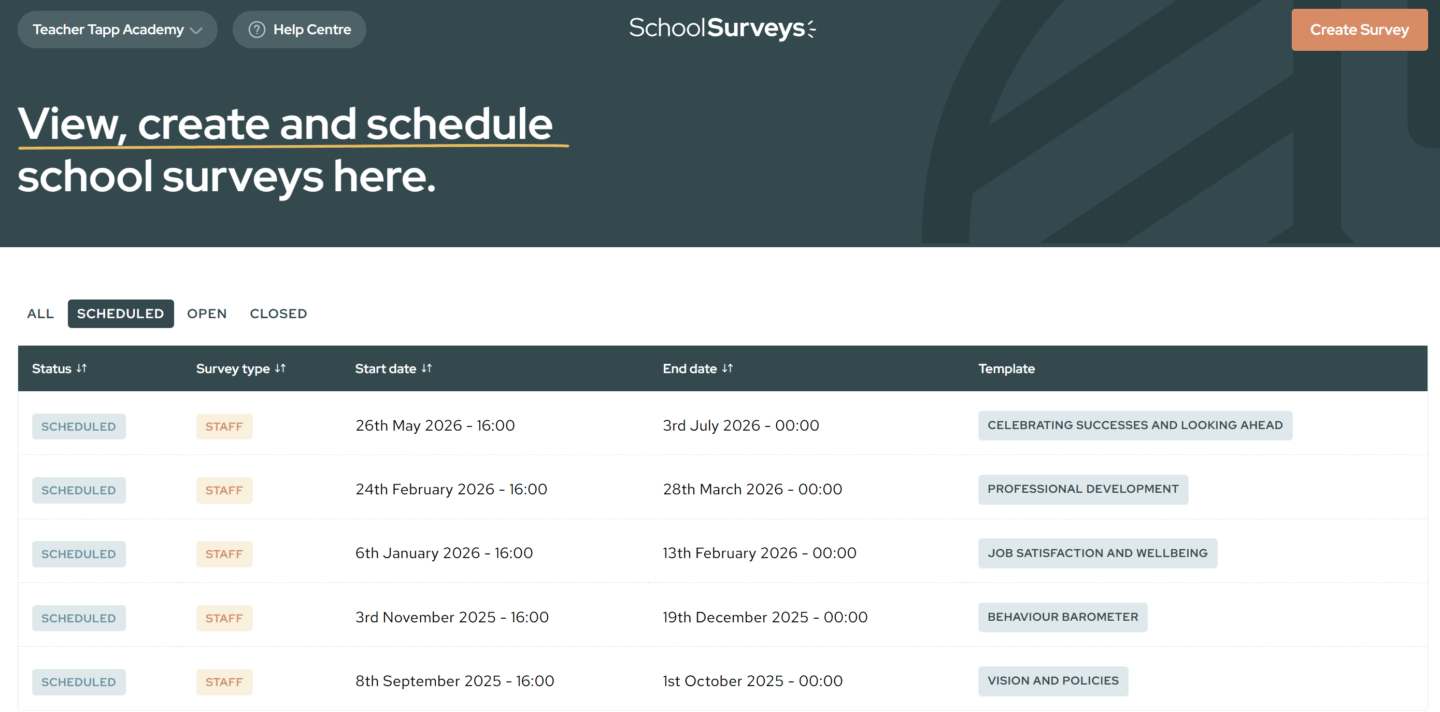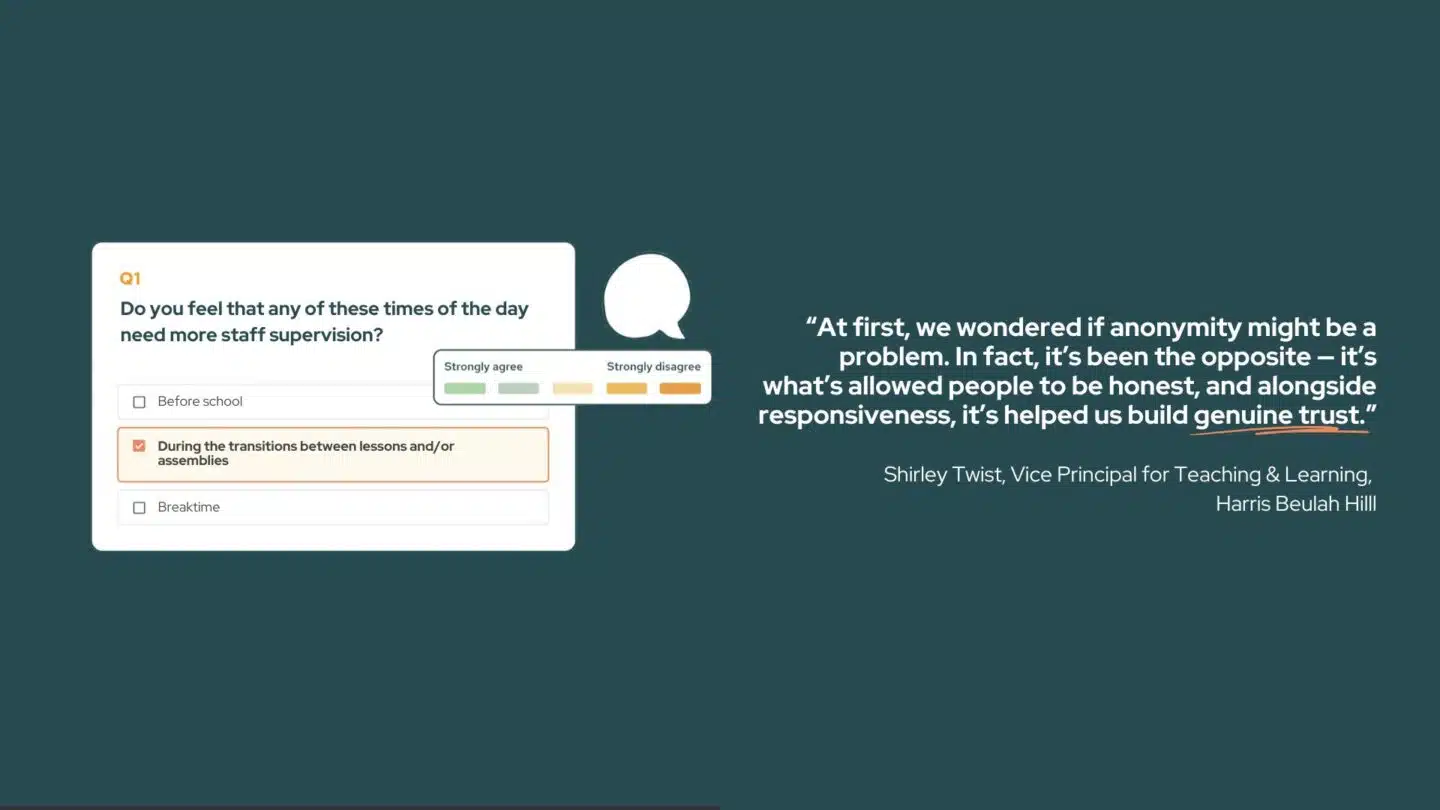Sometimes chatting to a leader about their surveying, it’s easy to see why school leadership can feel overwhelming. There are issues at every turn. Things that are changing (when aren’t they?). Things that have got harder in recent years as needs of all sorts have increased and budgets haven’t. On top of all the usual challenges of leading an organisation full of people with real lives and the ups and downs these bring.
Amongst all of this, when is the right time to survey? And what is it best to focus on?
Sometimes, it’s helpful to be given a plan. A clear one. Then you can react to that, and not have to start from scratch. Here it is!
A year in surveys

What’s in these surveys? Typically you can expect to find a template of around 6 – 10 questions that we know have been popular with school leaders. The first is the ‘content’ measure; the last is an open response question. None are mandatory. All of them will lead to benchmarked insights within the reports that are automatically generated when the survey closes.
Roughly, this is what to expect:
Staff surveys:
- Autumn 1 – vision and policies: a chance to check in with the whole team and gauge how clear everyone feels about the year ahead, the school’s expectations and the direction we’re aiming to go in.
- Autumn 2 – behaviour barometer: behaviour is consistently top of the Teacher Tapp panel’s list of concerns and these questions give you a chance to see where the pinch points are that need more focus. You may also have specific SDP areas that you’d like to ask about and this is an ideal time to get a sense of the first term’s progress with these.
- Spring 1 – job satisfaction and wellbeing: here’s your chance to find out what is most likely to help you motivate and retain staff as you reach the mid-year point.
- Spring 2 – professional development: check in with CPD impact and consider again gathering views on SDP progress. Depending on the length of the spring term, you may only choose to run only one of these two surveys, or an amalgamation of the two.
- Summer 1 – pause: it’s exam season and there’s a lot going on!
- Summer 2 – celebrating successes and looking ahead: this is a great time of year to ask staff to reflect on what has gone well as well as contribute thoughts for or on the emerging plan for the next year.
There are also some suggested parent and pupil surveys built into the schedule. Again, we have created templates to support parent and pupil surveying that we hope provides a useful starting point.
Commit now – tweak later (or not…)
Once the surveys have been scheduled, you can pursue all the hard work of leading your team, knowing that these surveys are ready to go out at the appropriate points during the school year. You can even add staff email addresses into the portal so that our system does all the notifications and reminders for you. You can simply await the report as each survey closes.

You might like to check in as the time nears for each survey to go live. You can invite colleagues into the portal and collaborate with them, re-visiting and previewing the scheduled survey and seeing if there are any tweaks that you’d like to make. Up until the point when a survey opens, it is possible to make as many changes as you wish.
What sorts of changes might you want to make and why?
- Adding extra questions. For example, there may be something you want to track progress on from last year, or a strand of the SDP that feels particularly important to take views on.
- Deletions – just as important as covering what you need, make sure you consider what not to ask. Don’t let a survey get too long. Past 10 questions and you may have people struggling to get to the end.
- Adjusting the survey window: you may like to change the dates. Remember, a survey close date can be extended, even once it is open. This can be particularly useful if you see that you need to give people an extra nudge and more time to complete a survey.
We’d suggest a few golden rules to bear in mind: keep surveys fairly short; have a slot for people to complete the them in (five minutes at the start of a staff meeting say?); and schedule in your plan for sharing outcomes. “You Said, We Did…” helps build trust, even if sometimes you are saying, “Here’s why we aren’t doing X”.
Making your own plan
Our Perfect Plan is all very well, but even better is to make your own. You can simply schedule your surveys directly into the portal, but sometimes it’s nice to work off a separate document that you can circulate separately and pore over together in a meeting.
Download and edit this template to help you formulate your own plan.

And remember that we are always on hand to talk things through – do book a support session to help with this whenever you need to.



